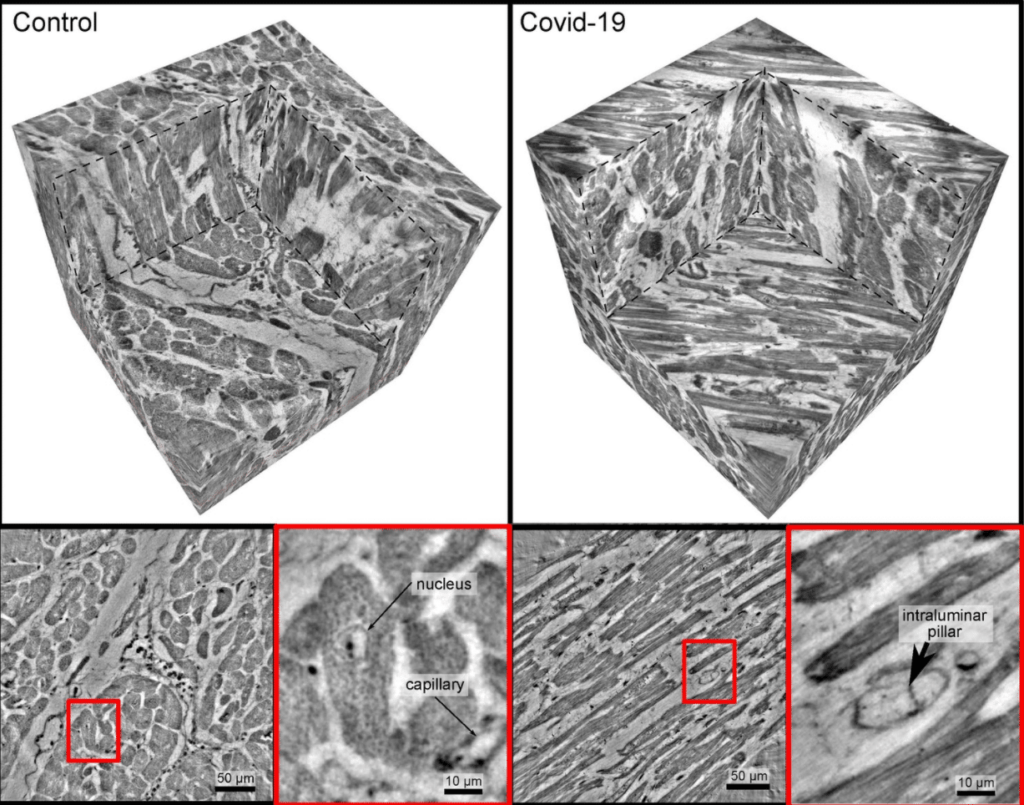An interdisciplinary research team from the Universities of Göttingen and the Hannover Medical School (MHH) has demonstrated significant changes in the heart muscle tissue of people who died from Covid-19.
Since damage to lung tissue has been the focus of science for a long time and is now well researched, the current study substantiates the involvement of the heart in Covid-19 for the first time on a cellular level through visualization and analysis of the affected tissue in the third dimension. The results appear in the specialist journal eLife.
The scientists imaged the tissue architecture with high resolution using synchrotron radiation - a particularly brilliant X-ray - and displayed it in three dimensions. To do this, they used a special X-ray microscope that the University of Göttingen built and operates at the German Electron Synchrotron DESY in Hamburg. In the severe course of Covid-19 disease they examined, they observed strong changes at the level of the finest vessels, the so-called capillaries, in the heart muscle tissue.

Misguided re-formation of the network as a result of Covid-19 creates numerous branches, ramifications and even loops in the capillaries, which can be analyzed mathematically using graphs. Photo: M. Reichardt, P. Møller Jensen, T. Salditt
In comparison to the healthy heart, a network full of splits, branches and loops was chaotically restructured through the formation and splitting of the vessels. These changes are the first direct visual evidence of a special form of new blood vessel formation in the tissue, called intussusceptive angiogens, one of the main drivers of lung damage in Covid-19. In order to visualize the capillary network, the vessels in the three-dimensional volume first had to be identified using machine learning methods. This initially required laborious marking of the image data “by hand”.
“In order to speed up image processing, we automatically broke down the tissue architecture into its local symmetry features and then compared them,” explains first author Marius Reichardt from the University of Göttingen. “The parameters obtained from this then showed a completely different quality compared to healthy tissue and diseases such as severe influenza and common myocarditis,” said the leaders of the study, Prof. Dr. Tim Salditt from the University of Göttingen and Prof. Dr. Danny Jonigk from the MHH.

While the vessels in the healthy case show an intact structure (bottom right), invaginations and column-like structures can be seen in the fine vessels (capillaries) in the Covid-19 tissue sample, which indicate certain morphological transformation processes of the vessels. Photo: M. Reichardt, T. Salditt
The special thing about this study: In contrast to the vascular architecture, the necessary data quality could be achieved using a compact X-ray source in the laboratory at the University of Göttingen - this could in principle also be implemented in any clinic in order to support pathologists in routine diagnostics. In the future, the researchers want to further expand the approach of converting the characteristic tissue patterns into abstract mathematical plots in order to develop automated tools for diagnostics , again through the further development of laboratory X-ray imaging and validation using synchrotron radiation. The collaboration with DESY will be further expanded in the coming years.
Original publication:
Marius Reichardt et al. 3D virtual histopathology of cardiac tissue from Covid-19 patients on phase-contrast x-ray tomography. eLife 2021. https://doi.org/10.7554/eLife.71359 .
Additional Information:
https://www.uni-goettingen.de/de/3240.html?id=6539 Photos
Notes:
1) This content reflects the current state of affairs at the time of publication. The reproduction of individual images, screenshots, embeds or video sequences serves to discuss the topic. 2) Individual contributions were created through the use of machine assistance and were carefully checked by the Mimikama editorial team before publication. ( Reason )

